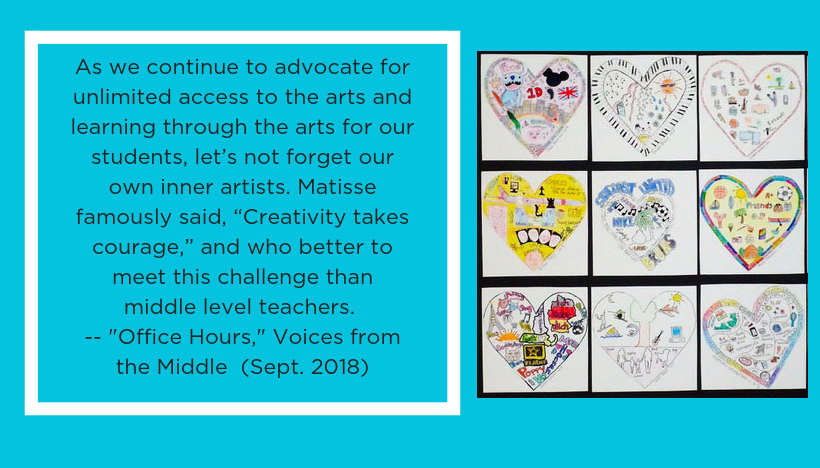This post by editors Sara Kajder and Shelbie Witte is reprinted from “Office Hours” in the September 2018 issue of Voices from the Middle.
“The arts empower. The arts give a voice to the voiceless. The arts help transform American communities and, as I often say, the result can be a better child, a better town, a better nation and certainly a better world. Let’s champion our arts action heroes, emulate them and make our communities everything we want them to be.” —Robert L. Lynch, President, Americans for the Arts
Over the past twenty years, there has been a steady decline in the offering of the “arts” in our schools. In this assessment era, electives are supplanted by additional reading and math interventions for adolescents, requiring students to miss classes that allow them the opportunity to perform, express, design, and tap into their creative genius.
As budgets and standardized curricula continue to drive the choices schools make, our classrooms and, ultimately, our students pay the price for the lack of creativity and opportunities for artistic expression in our schools. As is typically the case, middle level teachers are working tirelessly to supplement and to provide artistic outlets for middle level students.
In the call for manuscripts for this issue, we invited our readers to share the ways in which the arts are prevalent within their classrooms. We define the arts broadly here, in an effort to encompass music, art, dance, design, drama, and other artistic expressions of thought. We also encouraged our readers to think outside of the traditional box of a typical journal manuscript and submit a range of “texts” that displayed the creativity and multimodalities we embrace in the middle level classroom.
We asked a simple question: Wherefore “Art” Thou? And wow! You did not hesitate to show us.
Leading this issue, Christian Goering sounds the call for a world where the traditional English language arts class transforms into a multimodal arts exploration, encouraging us to imagine creating a space where creative expression is valued as highly as the traditional assessment and student engagement and inquiry that drive the curriculum.
Andrew Schoenborn answers Goering’s call, sharing how he transformed his teaching with the reintegration of the arts, reinvigorating his classroom and helping students find their voices through creative expression.
Through the arts, young adult author Jennifer Nielsen and New York City theater teacher Collin Andrulonis each examine how art impacted their life trajectories. Nielsen offers her suggestions for teachers to implement arts instruction and Andrulonis uses his journey from unathletic middle schooler to award-winning teacher to pay it forward in his classroom and offers us suggestions for how we can do the same.
Young Nae Choi invites us to build an engaged community of learners through dramatic techniques designed to integrate art, writing, poetry, and music. To counter those who believe artistic expression is without critical thinking, we offer Kari Loecker’s approach in using a social justice lens as a social critique of street art and young adult literature. We also share Christine Dawson’s framework of visual thinking strategies to help students bridge the visual to print and engage with unfamiliar texts.
Embracing the spirit of writing and reading as multimodal, Raven Bishop and Erin Counihan encourage us to implement art-making as part of the writing process, and Grace Enriquez and Amanda Claudia Wager guide us to understanding the performing arts as reader response.
For this volume, we are excited to welcome back Linda Rief and her students as they lead the Student Voices column and representatives of the Middle Level Section Steering Committee, who will provide insight into the governance of NCTE through section leadership and section activities.
We are thrilled to introduce a new slate of columnists to our team: Kym Sheehan contributes the voices of media specialists to our issues; Sarah Brown Wessling will share issues pertinent to new teachers to the field; Lori Goodson highlights the excellent work happening in each state through NCTE affiliates; and Jason Griffith will share approaches to using the latest young adult titles in the classroom.
As we continue to advocate for unlimited access to the arts and learning through the arts for our students, let’s not forget our own inner artists. Matisse famously said, “Creativity takes courage,” and who better to meet this challenge than middle level teachers.

